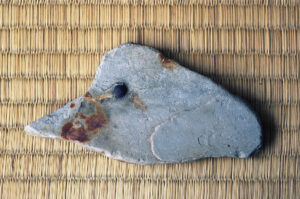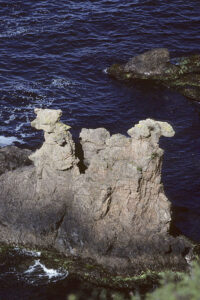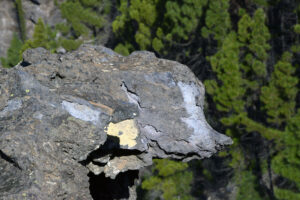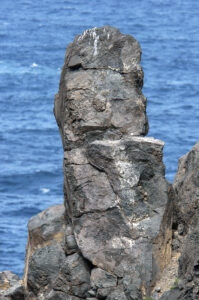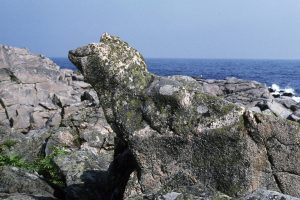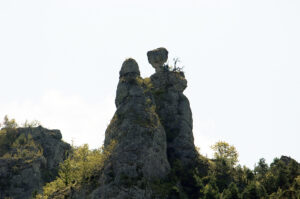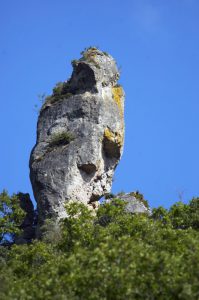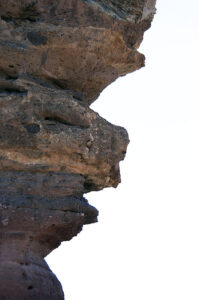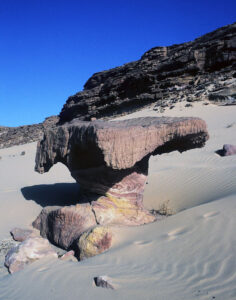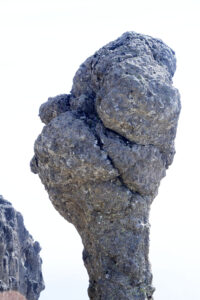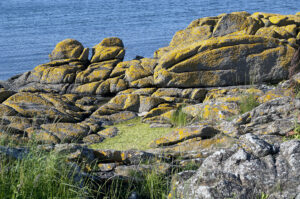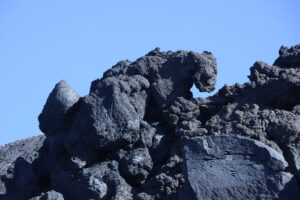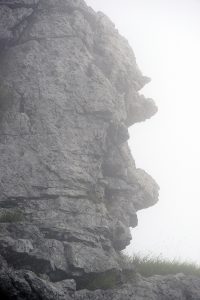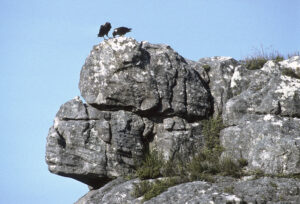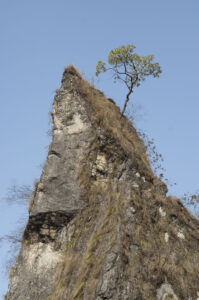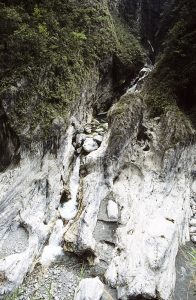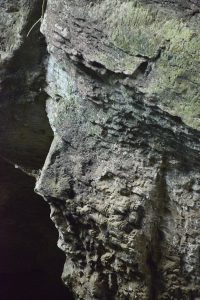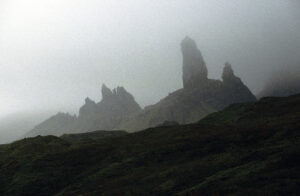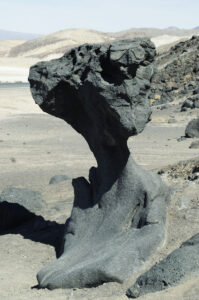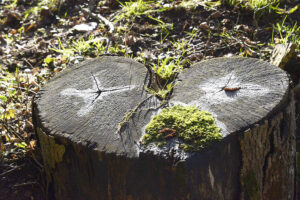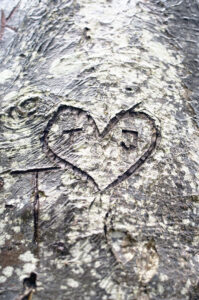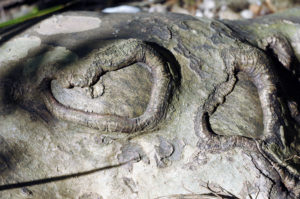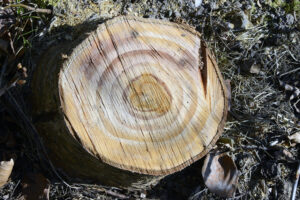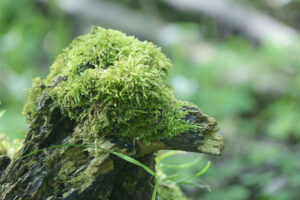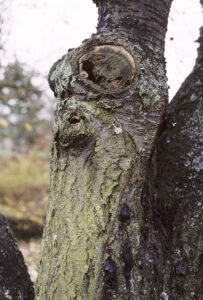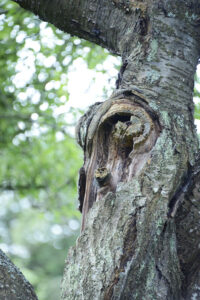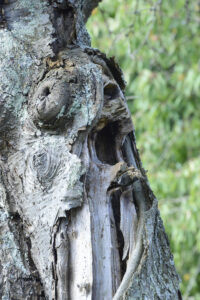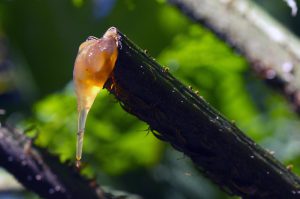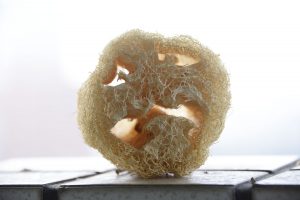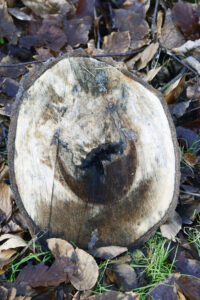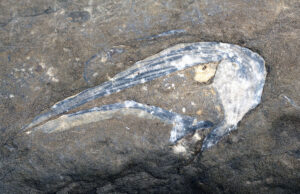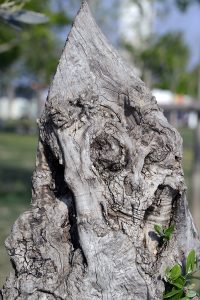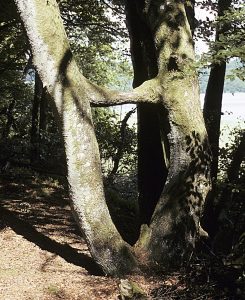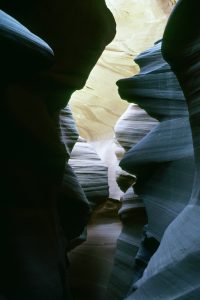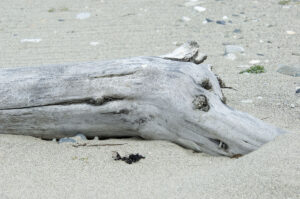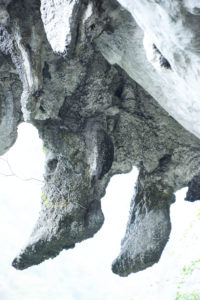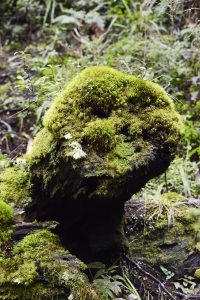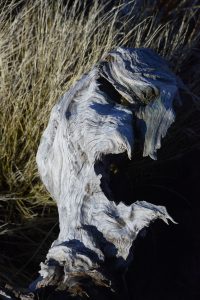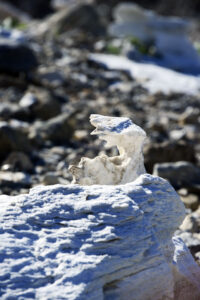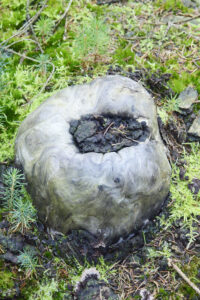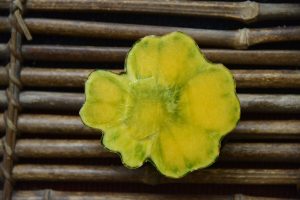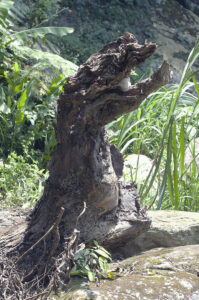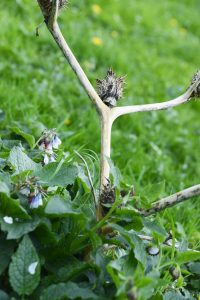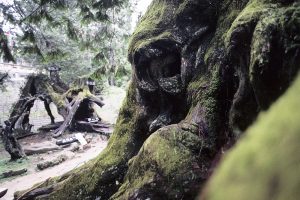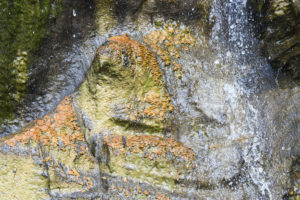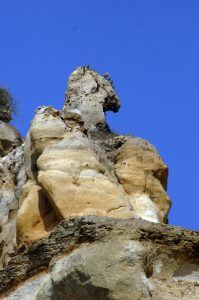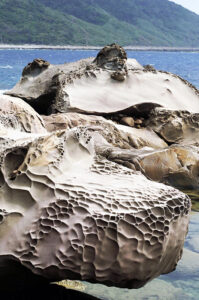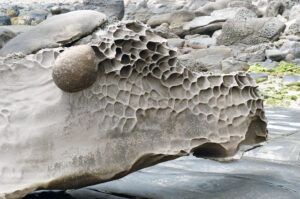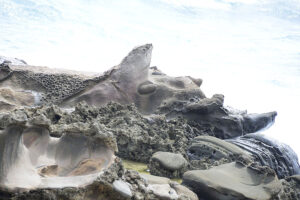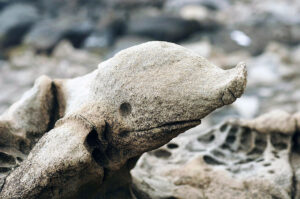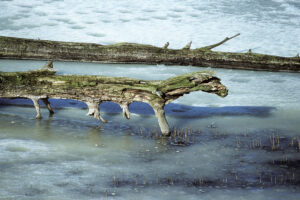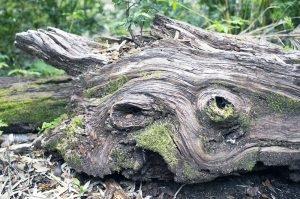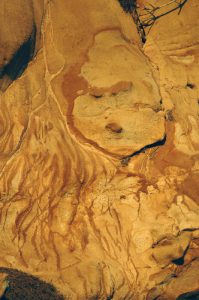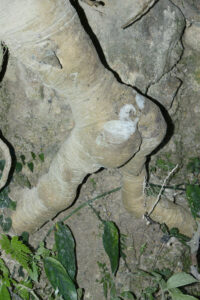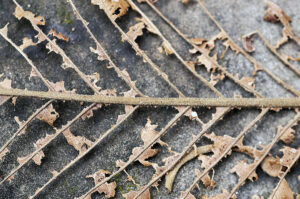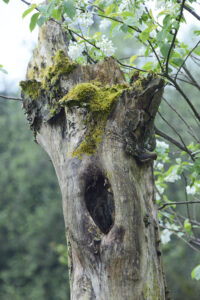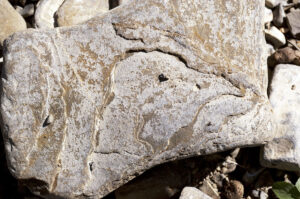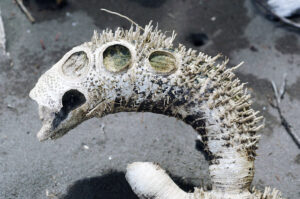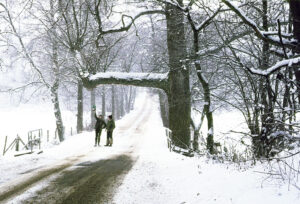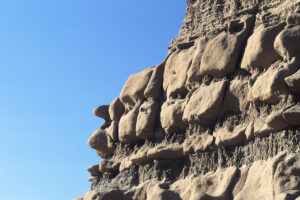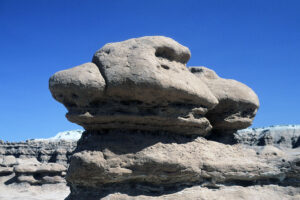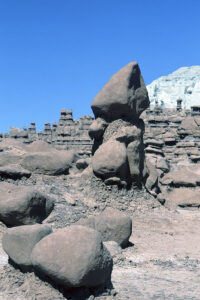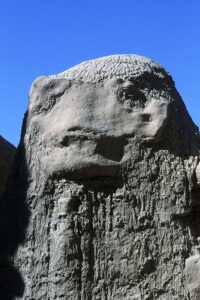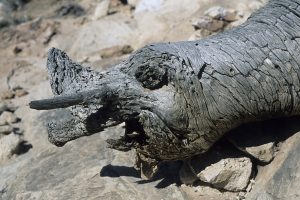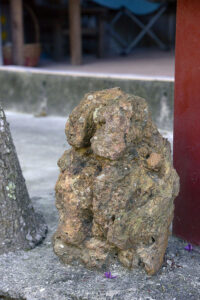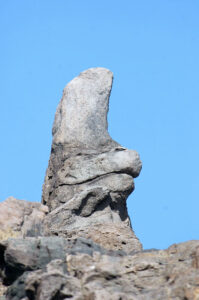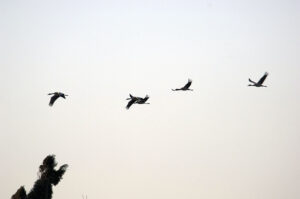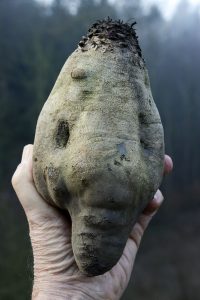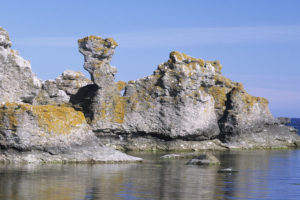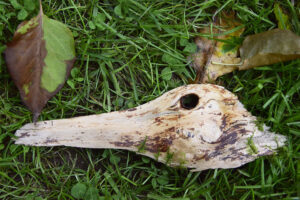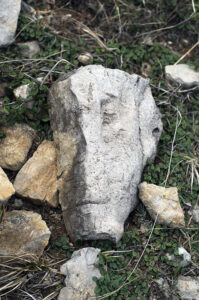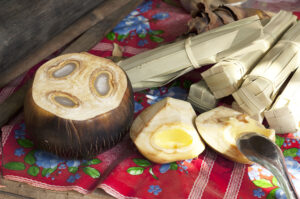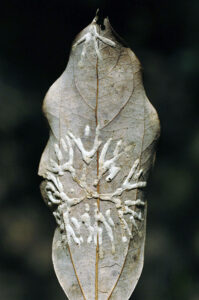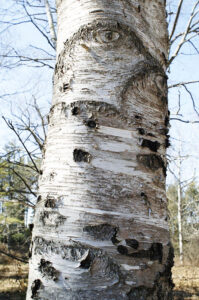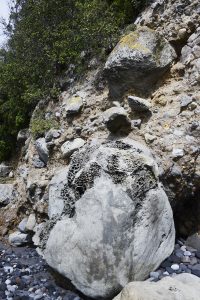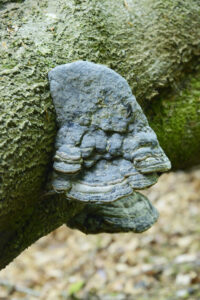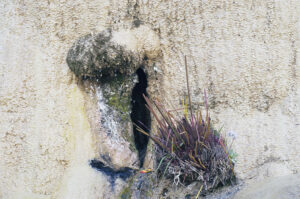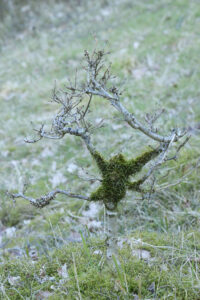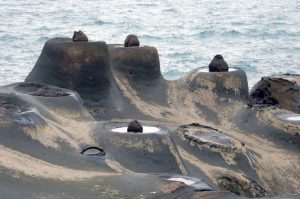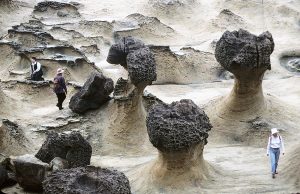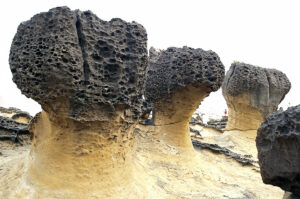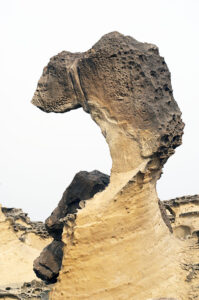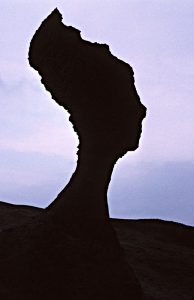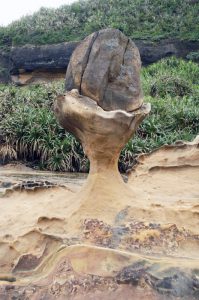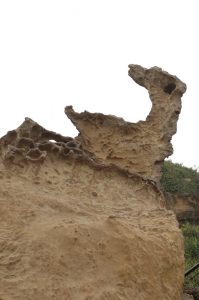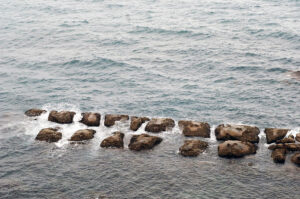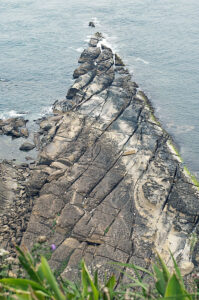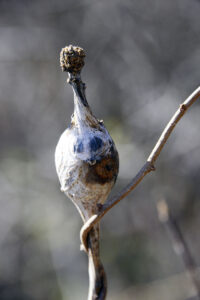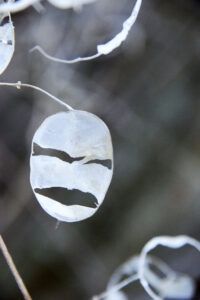Nature’s art
This piece of broken sandstone from the island of Öland, Sweden, forms the perfect image of the head of a goldeneye (Bucephala clangula). (Photo copyright © by Kaj Halberg)
Ever since I, as a young man, was fooled twice by the same tree stump, into believing that I had encountered a marten, I have made it a sport, during nature walks, to try to spot objects, rock formations, markings on rocks, etc., which resemble something – a famous person, an animal, a super-natural being, or other. Use your imagination on your next hike – and your trip may have a new dimension!
Forms, outlines, or edges of rocks often resemble something – but only from certain angles and distances. Several examples are shown below.
This coastal rock, off the coast of Bornholm, Denmark, was formed by rainfall, waves, and wind. It has been dubbed Kamelhovederne (‘Camel Heads’), although one of the figures resembles a wolf, rather than a camel. (Photo copyright © by Kaj Halberg)
This coastal rock formation at Xiao Yeliou, eastern Taiwan, resembles two wide-mouthed toads – or maybe fish. (Photo copyright © by Kaj Halberg)
The outline on this rock resembles the head of a female proboscis monkey (Nasalis larvatus), Tamadaba Natural Park, Gran Canaria. (Photo copyright © by Kaj Halberg)
Coastal rock, resembling a Chinese with a dog, Garachico, Tenerife, Canary Islands. (Photo copyright © by Kaj Halberg)
This eroded rock in Matobo National Park, Zimbabwe, resembles a seated person. (Photo copyright © by Kaj Halberg)
This eroded coastal rock on the island of Bornholm, Denmark, resembles a smiling dinosaur. (Photo copyright © by Kaj Halberg)
The outline of these coastal rocks in Salt Point State Park, California, photographed at sunset, resembles the profiles of two ogres, a large one and a small one, both with a pointed nose and open mouth. (Photo copyright © by Kaj Halberg)
These rocks at Gorge du Tarn, Cévennes, southern France, resemble a dancing couple. (Photo copyright © by Kaj Halberg)
This rock, also in the Cévennes, resembles a gnome, wearing the typical long hood. (Photo copyright © by Kaj Halberg)
The outline on this rock wall near Teide, Tenerife, Canary Islands, resembles a surprised monkey. (Photo copyright © by Kaj Halberg)
This eroded rock, resembling a giant mushroom, was observed in the desert near Nuweiba, Sinai, Egypt. (Photo copyright © by Kaj Halberg)
This rock resembles an elderly woman with her hair tied in a bun, Caldera Marteles, Gran Canaria. (Photo copyright © by Kaj Halberg)
These coastal rocks on the island of Bornholm, Denmark, resemble a large-eyed frog (left) and a wide-mouthed toad. They are covered by a species of orange lichen, Xanthoria aureola. (Photo copyright © by Kaj Halberg)
This lava formation on the slopes of the Etna Volcano, Sicily, resembles some bulbous-eyed animal. (Photo copyright © by Kaj Halberg)
In this rock in Triglavski National Park, Slovenia, which was photographed in foggy weather, you may see a friendly ogre with a prominent brow. (Photo copyright © by Kaj Halberg)
These rocks on the Table Mountain, Cape Town, South Africa, are shaped as the heads of two turtles. The birds are white-necked ravens (Corvus albicollis). (Photo copyright © by Kaj Halberg)
A sullen face is seen in this rock near Fakot, Uttarakhand, India, and the peak resembles a pointed hood. (Photo copyright © by Kaj Halberg)
This rock formation in the Liwa River Gorge, Taroko National Park, Taiwan, is called ‘Fish Jumping over the Dragon Gate’. The image of a giant fish is seen, ‘swimming’ along the gorge – the narrow, dark rock in the centre, with mosses and other plants forming the ‘scales’. (Photo copyright © by Kaj Halberg)
Face, outlined in a limestone rock, Mangapohue River Gorge, New Zealand. (Photo copyright © by Kaj Halberg)
Mist envelops a rock formation, called ‘The Old Man of Storr’, Isle of Skye, Inner Hebrides, Scotland. In fact, the faces of two lying ‘ogres’ can be seen – one smaller to the left with a heavy eyebrow, a small nose, and a protruding lower lip, and a larger one to the right with a very long nose and also a protruding lower lip. (Photo copyright © by Kaj Halberg)
‘E.T.’ (short for ‘extra-terrestrial’) is an alien in a film from 1982 by American director Steven Spielberg (born 1946). This creature, with a large, bulbous head, is left on the Earth by mistake and makes friends with a small boy. They go through many adventures, before E.T. is reunited with his family.
Sand, blown by the wind, has shaped this rock into an E.T.-like figure, Death Valley National Park, California. (Photo copyright © by Kaj Halberg)
Goblin Valley State Park, Utah, United States, is an area of Entrada Sandstone, which has been eroded by rainfall and wind into the weirdest forms, called goblins. This formation resembles E.T. (right) ‘kissing’ the dog Snoopy, a figure from the cartoon Peanuts, by Charles M. Schulz (1922-2000). (Photo copyright © by Kaj Halberg)
Heart shapes often occur in nature. Several examples are shown below.
These lichens, growing on a tombstone in the town of Nexø, Bornholm, Denmark, form the shape of a heart. – Other tombstones are depicted on the page Culture: Graves. (Photo copyright © by Kaj Halberg)
Heart-shaped tree stump, eastern Jutland, Denmark. The crack to the left resembles a pheasant’s footprint. (Photo copyright © by Kaj Halberg)
In former days, a common habit among lovers was to carve a heart in the bark of a tree, with your initials in the centre, and often Cupid’s dart through it. This habit has now largely disappeared.
Below, an example is shown in the bark of an old Swedish whitebeam (Sorbus x intermedia), observed on the island of Lyø, Funen, Denmark. This species is native to southern Sweden, the Danish island of Bornholm, south-western Finland, the Baltic countries, and northern Poland.
Swedish whitebeam is a natural hybrid, probably with genes from three species: rowan (S. aucuparia), wild service tree (S. torminalis), and common whitebeam (S. aria). The inflorescences are umbel-like, and, as opposed to the flowers of rowan, their fragrance is unpleasant. When left alone, this tree can grow very large, with a trunk diameter of up to 3 m, although specimens with a diameter below 1 m are much more common.
Rowan is described on the page Plants: Plants in folklore and poetry.
(Photo copyright © by Kaj Halberg)
Heart-shaped formation on a tree, formed by white lichens and liverworts, Mt. Taranaki, New Zealand. (Photo copyright © by Kaj Halberg)
Eight of the ten species of the magnificent plane trees, genus Platanus, are indigenous to North America, one is found in Laos and Vietnam, whereas the tenth species, the oriental plane tree (P. orientalis), is distributed from the Balkans and Turkey southwards to Jordan, but may be a native as far west as Italy, and as far east as Kashmir in northern India. As it is widely cultivated, it is often difficult to decide, whether a population is indigenous or not.
The generic name is from the Greek platanos, which was the ancient name of maple trees (Acer). It refers to the maple-like leaves of the oriental plane tree. Some North American species are called sycamores, likewise referring to the leaves, which resemble those of the European sycamore maple (Acer pseudoplatanus).
American sycamore (Platanus occidentalis), also known as American planetree, is native to the eastern part of North America, from extreme southern Canada southwards to the mountains of north-eastern Mexico. The specific name is Latin for ‘western’, referring to the New World. At the time when it was named by Swedish naturalist Carl Linnaeus (1707-78), the only other known species in the genus was P. orientalis (‘eastern’), which is restricted to Eurasia.
Plane trees are described in depth on the page Plants: Ancient and huge trees.
Scar tissue on an exposed root of American sycamore, presumably formed around carved hearts, Lexington, Kentucky, United States. (Photo copyright © by Kaj Halberg)
The native area of the wild cherry (Prunus avium) was probably from France across central and southern Europe to the Caucasus. Today, it is cultivated in numerous countries around the world, in Europe as far north as Denmark and southern Sweden. As its name implies, it often becomes naturalized.
Cherry species are dealt with in detail on the page Plants: Plants in folklore and poetry.
Stump of a wild cherry with concentric rings, surrounding a ‘heart’, Funen, Denmark. (Photo copyright © by Kaj Halberg)
Countless plant species have heart-shaped leaves. Here, a single example is shown. The parasol-leaf tree (Macaranga tanarius), also called heart leaf or nasturtium tree, belongs to the spurge family (Euphorbiaceae). It is native to eastern China, Taiwan, Southeast Asia, Indonesia, the Philippines, New Guinea, and eastern Australia.
Heart in front of a heart – two leaves of parasol-leaf tree. This picture is from Taiwan, where this species is very common. (Photo copyright © by Kaj Halberg)
Moss-covered stump, resembling an eagle, Boserup Forest, Roskilde, Denmark. (Photo copyright © by Kaj Halberg)
The following 3 pictures show the decay, taking place in an old sweet cherry (Prunus avium), which grew in our garden in eastern Funen, Denmark. Once upon a time, two branches were cut off, and in 2003, the knots, together with scars beneath them, resembled some large-eyed extra-terrestrial with one nostril and a small mouth (top).
In 2017, 14 years later, further decay had changed the features of the alien, which now had bulbous eyes and a long, beak-like nose (centre).
In 2021, the tree finally died. The alien now had a large, upturned nose and a gaping mouth (bottom).
The tree fell in a storm in 2023.
(Photos copyright © by Kaj Halberg)
Sap, oozing out of a cut tree fern leaf, resembles the head of an anteater, Santa Elena Cloud Forest, Cordillera de Tilarán, Costa Rica. (Photo copyright © by Kaj Halberg)
Angled luffa (Luffa acutangula), also called ridged gourd, sponge gourd and many other names, is a native of Tropical Asia, where it is also widely cultivated. Young fruits are cooked as a vegetable, or pickled, whereas the fibres inside mature fruits are used as a sponge or for making hats. The species is also utilized in traditional folk medicine. The seeds are emetic and purgative, and they are eaten to expel intestinal worms. Fruit and seeds are also used in treatment of venereal diseases, especially gonorrhea.
These two pictures show cross-sections of the dried interior fibrous layer of angled luffa fruits, with air channels, which resemble a toothed monster (top) and a sad face. (Photos copyright © by Kaj Halberg)
The markings on this piece of sawn wood resemble a round-faced, smiling man with a black moustache, eastern Jutland, Denmark. (Photo copyright © by Kaj Halberg)
Minerals, forming an image of a gull’s head in a rock, Cirque de Gavarnie, Pyrenees, France. (Photo copyright © by Kaj Halberg)
Guava (Psidium guajava) is a small tree of the myrtle family (Myrtaceae), native to the Caribbean, and from Mexico eastwards to northern South America. Today, it is cultivated in many tropical and subtropical regions. As almost ripe, the fruit has a fresh, slightly sour taste, whereas a ripe one has a sweet taste. Over-ripe fruits are not very pleasant, having a sickly taste.
When Judy cut this guava fruit in half, this happy face emerged, where seeds are forming eyes, nostrils, and a mouth with a licking tongue. We did not manipulate the seeds! (Photo copyright © by Kaj Halberg)
An ogre with grimacing mouth and flat boxer’s nose, wearing a pointed hood, is seen in the right part of this tree stump in Istanbul, Turkey. (Photo copyright © by Kaj Halberg)
The trunk of this tree in central Jutland, Denmark, divided into two at an early stage, but maybe they couldn’t do without each other? (Photo copyright © by Kaj Halberg)
Pomelo (Citrus maxima) is a large citrus fruit, measuring up to 30 cm across, with a thick, spongy skin and sweet flesh. This species originates in Southeast Asia and Malaysia, but is widely cultivated elsewhere, especially in China and Taiwan.
Other citrus species are described on the page Plants: Plants in folklore and poetry.
Friendly face in a dried-out pomelo, Taiwan. (Photo copyright © by Kaj Halberg)
The incredibly narrow Antelope Canyon, Arizona, United States, has been eroded down into the Colorado Plateau by flash floods – a process, which has taken place over millions of years.
These formations in the canyon wall in Antelope Canyon resemble a baboon’s face (top) and a lion’s head. (Photo copyright © by Kaj Halberg)
In severe winters, each falling tide leaves a thin layer of frozen saltwater on emerging stones. The following rising tide will press this layer outwards, leaving a new thin layer of ice inside the previous layer. In this way, several rising and falling tides create a ’flower’ with delicate ice petals.
‘Ice flower’, Horsens Fjord, Denmark. (Photos copyright © by Kaj Halberg)
Other ice sculptures, formed around stones in shallow water in Horsens Fjord, are seen below.
(Photos copyright © by Kaj Halberg)
This piece of driftwood, encountered on the sandspit Kosa Ruskaya Koshka, on the Chukotka Peninsula, eastern Siberia, resembles some toothed carnivore. (Photo copyright © by Kaj Halberg)
Wonderful rock formations are created in limestone caves under certain pH conditions. Rain water, which contains carbon dioxide, seeps through cracks in the limestone and dissolves tiny amounts of calcium carbonate and other minerals. Over the millennia, various types of calcium bicarbonate structures are formed in the cave.
The commonest types are stalagmites (Greek for ‘dropping’ or ‘trickling’), which rise from the floor of the cave, when water drips from the ceiling, causing the minerals to be deposited, and stalactites, the corresponding type that hangs down from the ceiling. Often, the two types connect to form columns.
These eroded stalagmites in the Sung Sot Cave (‘Surprise Cave’), Halong Bay, Vietnam, resemble the feet of a giant. (Photo copyright © by Kaj Halberg)
The moss cushions, growing on this tree stump in Tongariro National Park, New Zealand, resemble a jowly, snarling monster. (Photo copyright © by Kaj Halberg)
A combination of light and shadow on this dead tree creates what resembles a toothless, gaping monster, with long, wavy Elvis Presley-hair hanging down over his face. – Tongariro National Park. (Photo copyright © by Kaj Halberg)
Another gaping monster is seen in this limestone rock, Col du Mt. Cenis, French Alps. (Photo copyright © by Kaj Halberg)
Balsams (Impatiens) are widely distributed in temperate areas of the Northern Hemisphere, and in montane areas of the Tropics. This large genus has attractive flowers of a unique structure, having 3 or 5 sepals, of which the lower one is greatly enlarged to form a pouch with a spur, and the other 2 or 4 are small and greenish. There are 5 petals, of which the upper one is often helmet-like, whereas the 4 lateral ones are fused in pairs, the upper pair forming the wings, the lower pair the lip.
The generic name, as well as popular names of these plants, like touch-me-not and snapweed, were given in allusion to their way of spreading their seeds. As the fruit reaches maturity, a tension builds up inside the pod, causing it to ‘explode’ when touched, hereby spreading the seeds a considerable distance.
Several Himalayan balsam species are described on the page Plants: Himalayan flora.
In this picture from the Upper Marsyangdi Valley, Annapurna, central Nepal, some of the flowers of this Impatiens bicornuta rather resemble French artist Auguste Rodin’s sculpture The Thinker. (Photo copyright © by Kaj Halberg)
This conifer in central Jutland, Denmark, was once felled, and during the following years, porcelain-like scar tissue attempted to cover the stump. (Photo copyright © by Kaj Halberg)
The name Cucurbita pepo covers several varieties of cultivated fruits, including pumpkin, winter squash, and summer squash, besides a number of ornamental forms. Botanically, these fruits are berries. This species originated in Mexico, where it has been cultivated for thousands of years. Some taxonomists recognize C. pepo as a species with three subspecies: pepo, which is only known in cultivation, fraterna, which grows in the wild in north-eastern Mexico, and texana, which grows in the wild in Texas. Others claim that fraterna is the original species, with subspecies pepo as the cultivated form.
This slice of a pumpkin, cut near the stalk, resembles a flower. (Photo copyright © by Kaj Halberg)
This tree stump near the Penglai River, Lion’s Head Mountain, northern Taiwan, resembles a hissing dragon. (Photo copyright © by Kaj Halberg)
Common thorn-apple (Datura stramonium) is described on the page Plants: Plants in folklore and poetry.
Dancing man, wearing a spiny mask? – No, a withered common thorn-apple with fruits. To the left a cultivated species of comfrey (Symphytum). – Funen, Denmark. (Photo copyright © by Kaj Halberg)
Two species of false cypresses, of the genus Chamaecyparis, are native to Taiwan, the Taiwan red cypress (C. formosensis) and the Taiwan yellow cypress (C. obtusa var. formosana), both growing in areas of high precipitation at medium elevations, between 1,300 and 2,600 m altitude.
These magnificent trees are described in depth on the page Plants: Ancient and giant trees.
The lower part of the trunk of this old red cypress, growing in Alishan National Forest, resembles a kneeling elephant. (Photo copyright © by Kaj Halberg)
Orange end green algae on this wet rock in a park in Taichung, Taiwan, resemble a rather sleepy dinosaur. (Photo copyright © by Kaj Halberg)
Eroded coastal bluff, resembling an eagle, Torrey Pines State Beach and Reservation, California, United States. (Photo copyright © by Kaj Halberg)
Tetrameles nudiflora is a huge rainforest tree, which can grow to a height of 45 m. It is distributed in the Indian Subcontinent and in Southeast Asia, southwards through Malaysia and Indonesia to northern Australia.
Other pictures, depicting this species, are shown on the page Plants: Ancient and giant trees.
Swellings on the lower trunk of this giant Tetrameles nudiflora, growing at the entrance to Ta Prohm, Angkor Wat, Cambodia, somewhat resemble a couple, mourning over a deceased person. (Photo copyright © by Kaj Halberg)
Many of the coastal rocks at Jialeshuei, Kenting National Park, southern Taiwan, have been eroded into resembling various animals.
This rock resembles a gigantic frog, swallowing rocks. (Photo copyright © by Kaj Halberg)
Dog with rounded ears. (Photo copyright © by Kaj Halberg)
Head of a rhino. (Photo copyright © by Kaj Halberg)
A friendly anteater – or maybe a pig. (Photo copyright © by Kaj Halberg)
This coastal rock on Bornholm, Denmark, is illuminated by the setting sun, causing it to resemble a smiling gorilla. (Photo copyright © by Kaj Halberg)
This decaying tree trunk, observed in a pond in Nature Reserve Vorsø, Jutland, Denmark, resembles a walking animal with skinny legs and a huge, hairy penis. (Photo copyright © by Kaj Halberg)
Coigüe (Nothofagus dombeyi) is one among ten species of southern beeches in Chile, described in detail on the page Travel episodes – Chile 2011: The white forest.
A ‘monster’ can be seen in the trunk of this dead coigüe in Parque Nacional Conguillio, Chile. (Photo copyright © by Kaj Halberg)
Coastal bluff in evening light, showing a ‘face’, Salt Point State Park, California. (Photo copyright © by Kaj Halberg)
These tree roots resemble behind and legs of a naked running woman. They were seen in a forest near Puli, Taiwan. (Photo copyright © by Kaj Halberg)
This formation in the ancient Kana’a Lava Flow, Coconino National Forest, Arizona, resembles a pig. (Photo copyright © by Kaj Halberg)
Dipterocarpus alatus is a large evergreen forest tree, which can grow to a height of 40 m, sometimes up to 55 m. It is found in tropical Asia, from Bangladesh eastwards through Southeast Asia to the Philippines. It is one of the most important timber species in this region, and wild populations are highly threatened by habitat loss. It is listed as Endangered in the IUCN Red List of Threatened Species.
The generic name is derived from the Greek words di (‘two’), pteron (‘wing’), and karpos (‘fruit’), referring to the two-winged fruits of this genus. Fruits are depicted on the page Plants: Ancient and huge trees.
This leaf of Dipterocarpus alatus, which has fallen among the ruins of Angkor Thom, Cambodia, displays a beautiful pattern, created by micro-organisms, which have eaten most of it. (Photo copyright © by Kaj Halberg)
This dead tree resembles a gaping monster, Store Hjøllund Plantation, Jutland, Denmark. (Photo copyright © by Kaj Halberg)
This tree trunk, which has been washed ashore on a sandy beach on Bornholm, Denmark, resembles a creeping monster. (Photo copyright © by Kaj Halberg)
This impression in a rock in Valle Hecho, Pyrenees, Spain, resembles the head of a bird of prey. (Photo copyright © by Kaj Halberg)
This withered bamboo root, washed ashore on a beach near Tortuguero National Park, Limón, Costa Rica, resembles a six-eyed, hairy monster. (Photo copyright © by Kaj Halberg)
In former days, poplars (Populus) were often planted along roads and between fields, as they would provide people with branches for countless purposes. This repeated pruning often kept the poplars low and gnarled. Today, the poplars are often pruned to keep them low, as high poplars often break during storms and can be a hazard to traffic. Details of old, stunted poplars often resemble monsters or other images.
Pruned poplars in morning sun, Lyø, Funen, Denmark. The one in front resembles a gaping monster. (Photo copyright © by Kaj Halberg)
This thick branch of a formerly pruned Canadian poplar (Populus x canadensis) overhangs a road in Jutland, resembling – yes, what do you think? (Photo copyright © by Kaj Halberg)
Goblin Valley State Park, Utah, United States, is an area of Entrada Sandstone, which has been eroded by rainfall and wind into the weirdest forms, called ‘goblins’.
In the folder, presenting Goblin Valley State Park, this formation is called ‘The Guardians’. (Photo copyright © by Kaj Halberg)
This one might be called ‘Parade of Gorillas’. (Photo copyright © by Kaj Halberg)
Swag-bellied gorilla. (Photo copyright © by Kaj Halberg)
Yet another gorilla, together with a hippo. (Photo copyright © by Kaj Halberg)
Two ogres. (Photo copyright © by Kaj Halberg)
Toothless old man. (Photo copyright © by Kaj Halberg)
Gnome with a big nose, fat belly, and pointed hat. (Photo copyright © by Kaj Halberg)
Ogre with a long beard. (Photo copyright © by Kaj Halberg)
Part of the outer husk of a coconut has been washed ashore on a beach in Tortuguero National Park, Limón, Costa Rica, somewhat resembling a hairy beetle. (Photo copyright © by Kaj Halberg)
This trunk of a dead pine (Pinus) resembles a long-nosed monster, Natural Bridges National Monument, Utah, United States. (Photo copyright © by Kaj Halberg)
This rock near Guoxing, Taiwan, resembles two monkeys, huddling together. (Photo copyright © by Kaj Halberg)
Santuario de la Naturaleza Granito Orbicular is an area north of Caldera, Chile, where granite rocks have been eroded into peculiar formations.
Figures in this rock resemble an angry old man and a baboon with a fat belly (at the rear). (Photo copyright © by Kaj Halberg)
This rock resembles a cassowary. (Photo copyright © by Kaj Halberg)
This bush resembles a woman, waving to passing black-necked cranes (Grus nigricollis), Cao Hai Lake, Guizhou Province, China. This crane is described on the page Travel episodes – China 2009: Among black-necked cranes. (Photo copyright © by Kaj Halberg)
Elephant seals derive their name from their great size, and also from the male’s large, inflatable proboscis, with which he makes loud roaring noises, especially during the mating season. These giant beasts were once on the brink of extinction, described on the page Folly of Man.
This large red beet (Beta vulgaris ssp. vulgaris) resembles the head of a male elephant seal. (Photo copyright © by Kaj Halberg)
Raukar is the Swedish term of a type of rocks, found on coasts of the Swedish islands Gotland and Öland. A rauk is formed through erosion from waves, which erode away softer parts of the rocks, leaving a core of harder limestone. Since the melting of the ice that covered Sweden during the latest Ice Age, the land has been rising, causing many rauks to be above the sea surface today.
This rauk on the island of Fårö, Gotland, Sweden, is aptly named Hunden (‘The Dog’). (Photo copyright © by Kaj Halberg)
This rauk at Holmhällar, southern Gotland, resembles a resting dromedary. (Photo copyright © by Kaj Halberg)
This sawn-off bit of wood from a conifer resembles a gull’s head. – Jutland, Denmark. (Photo copyright © by Kaj Halberg)
This stone, found in a field in the Guizhou Province, China, resembles a longish face. (Photo copyright © by Kaj Halberg)
The native range of the Asian palmyra palm (Borassus flabellifer) is the Indian Subcontinent and Indochina, with disjunct populations in Java and the Lesser Sunda Islands. Its fruit is edible and sweet. A sugary sap, called toddy, can be obtained from the young inflorescence. It is fermented to make palm wine or a strong alcoholic drink, arrack. It may also be concentrated to a sweet, hard substance, in India called jaggery. It is used as a substitute for sugar. Palm wine is consumed in huge quantities in India and Sri Lanka.
This opened fruit of Asian palmyra palm (left) resembles a sad-faced alien. To the right is sugar, made from the fruits, wrapped in leaves and displayed for sale, Banteay Srey, Angkor, Cambodia. (Photo copyright © by Kaj Halberg)
Fungi on a withered leaf, creating a beautiful design, Basianshan National Forest, Taiwan. (Photo copyright © by Kaj Halberg)
The grey birch (Betula populifolia) is found in eastern North America, from Ontario and Nova Scotia south to Pennsylvania and New Jersey, with isolated populations in Virginia, North Carolina, and Indiana. It is often a pioneer tree, invading abandoned fields and burned areas.
The outline of a bird’s head, with a very large eye, may be seen in the bark on the upper part of the trunk of this grey birch, Maudslay State Park, Massachusetts. (Photo copyright © by Kaj Halberg)
This shrivelled moon jellyfish (Aurelia aurita), stuck on a washed-up, algae-covered plank, somewhat resembles a sad alien, Horsens Fjord, Denmark. (Photo copyright © by Kaj Halberg)
This rock at Omata Beach, New Zealand, resembles the head of a giant lizard. (Photo copyright © by Kaj Halberg)
The tinder polypore (Fomes fomentarius), also known as hoof fungus, is a parasitic fungus on various trees, but mainly on beech (Fagus sylvatica). It is widely distributed in Europe, Asia, Africa, and North America. It has very large fruit bodies, often shaped like a horse hoof, often being grey, but sometimes brown or black. When the host tree dies, the fungus changes from being a parasite to being a decomposer.
The common name refers the former usage of this fungus as tinder. It was also used to make clothing and other items.
This tinder polypore, growing on a toppled beech, resembles a face, Velling Forest, Jutland, Denmark. (Photo copyright © by Kaj Halberg)
Before the introduction of religions like Hinduism, Buddhism, Christianity, and Islam, worship of natural features was very common. Such worship is described in depth on the page Religion: Animism.
The picture below shows a crack in deposits of calcium bicarbonate at the Baishui Terraces, Yunnan Province, China. This crack resembles a vagina, and a knot above it are the ‘pubic hairs’. This formation is still sacred to the local people, who worship it. Incense sticks have been stuck into a grass tuft beneath the crack, in which a primrose (Primula) is growing.
(Photo copyright © by Kaj Halberg)
A ‘naughty’ carrot, Öland, Sweden. (Photo copyright © by Kaj Halberg)
Moss, growing on a young oak, resembles a green, very hairy orangutan, climbing a tree, Jutland, Denmark. (Photo copyright © by Kaj Halberg)
Erosion from sea and wind has shaped the soft Daliao Sandstone rocks in Yeliou Geopark, northern Taiwan, creating fantastic formations.
These formations have been formed by stones, rotating in depressions in the rock. (Photo copyright © by Kaj Halberg)
Gigantic mushrooms. (Photos copyright © by Kaj Halberg)
Camel. (Photo copyright © by Kaj Halberg)
This rock resembles Nefertiti, queen of Pharaoh Akhenaten, who ruled Ancient Egypt from 1353 to 1335 B.C. (Photo copyright © by Kaj Halberg)
Dog, sniffing another dog. (Photo copyright © by Kaj Halberg)
Boiled egg in an egg-cup. (Photo copyright © by Kaj Halberg)
Gaping monster. (Photo copyright © by Kaj Halberg)
These flat, horizontal rocks are called ‘Tofu Rock’, as they resemble tofu, cut into squares. (Photo copyright © by Kaj Halberg)
This flat, horizontal rock has been eroded to form the outline of a pyramid. (Photo copyright © by Kaj Halberg)
The markings on this gall, growing on an old stem of a species of goldenrod (Solidago), resembles a face, Tattersall Farm Conservation Area, Haverhill, Massachusetts, United States. (Photo copyright © by Kaj Halberg)
Honesty (Lunaria annua) is a plant of the cabbage family (Brassicaceae), whose flat, circular fruits (siliculas) have given rise to the generic name, which means ‘moon-like’. The two halves of the silicula are divided by a shining membrane, which remains on the plant for a long time, after the seeds have fallen off.
This membrane of honesty has cracked, so that it resembles a mask with an angry face. – Funen, Denmark. (Photo copyright © by Kaj Halberg)
(Uploaded June 2016)
(Latest update May 2024)
